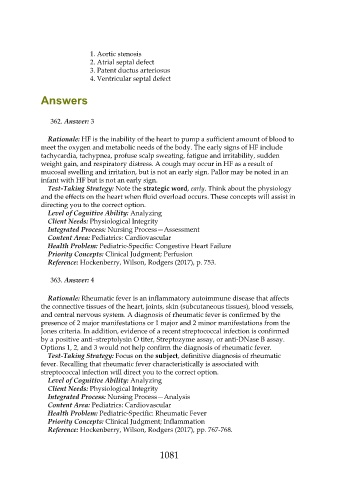Page 1081 - Saunders Comprehensive Review For NCLEX-RN
P. 1081
1. Aortic stenosis
2. Atrial septal defect
3. Patent ductus arteriosus
4. Ventricular septal defect
Answers
362. Answer: 3
Rationale: HF is the inability of the heart to pump a sufficient amount of blood to
meet the oxygen and metabolic needs of the body. The early signs of HF include
tachycardia, tachypnea, profuse scalp sweating, fatigue and irritability, sudden
weight gain, and respiratory distress. A cough may occur in HF as a result of
mucosal swelling and irritation, but is not an early sign. Pallor may be noted in an
infant with HF but is not an early sign.
Test-Taking Strategy: Note the strategic word, early. Think about the physiology
and the effects on the heart when fluid overload occurs. These concepts will assist in
directing you to the correct option.
Level of Cognitive Ability: Analyzing
Client Needs: Physiological Integrity
Integrated Process: Nursing Process—Assessment
Content Area: Pediatrics: Cardiovascular
Health Problem: Pediatric-Specific: Congestive Heart Failure
Priority Concepts: Clinical Judgment; Perfusion
Reference: Hockenberry, Wilson, Rodgers (2017), p. 753.
363. Answer: 4
Rationale: Rheumatic fever is an inflammatory autoimmune disease that affects
the connective tissues of the heart, joints, skin (subcutaneous tissues), blood vessels,
and central nervous system. A diagnosis of rheumatic fever is confirmed by the
presence of 2 major manifestations or 1 major and 2 minor manifestations from the
Jones criteria. In addition, evidence of a recent streptococcal infection is confirmed
by a positive anti–streptolysin O titer, Streptozyme assay, or anti-DNase B assay.
Options 1, 2, and 3 would not help confirm the diagnosis of rheumatic fever.
Test-Taking Strategy: Focus on the subject, definitive diagnosis of rheumatic
fever. Recalling that rheumatic fever characteristically is associated with
streptococcal infection will direct you to the correct option.
Level of Cognitive Ability: Analyzing
Client Needs: Physiological Integrity
Integrated Process: Nursing Process—Analysis
Content Area: Pediatrics: Cardiovascular
Health Problem: Pediatric-Specific: Rheumatic Fever
Priority Concepts: Clinical Judgment; Inflammation
Reference: Hockenberry, Wilson, Rodgers (2017), pp. 767-768.
1081

